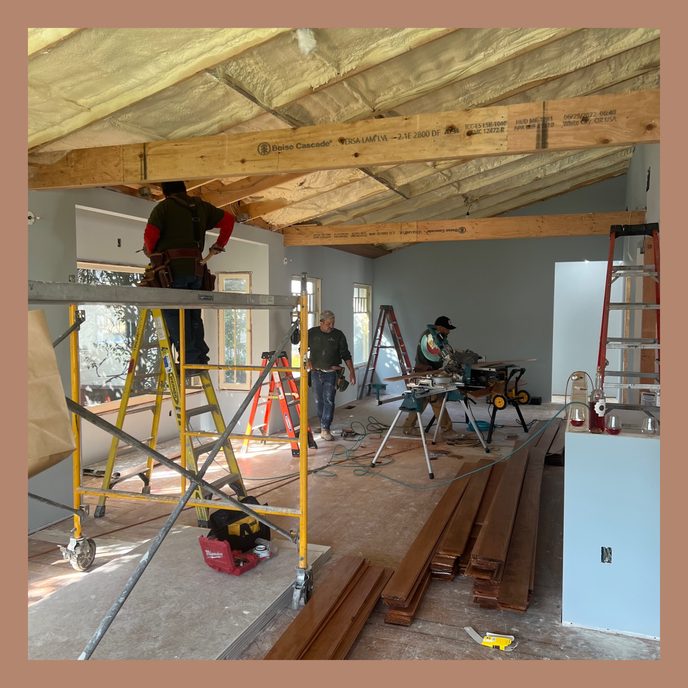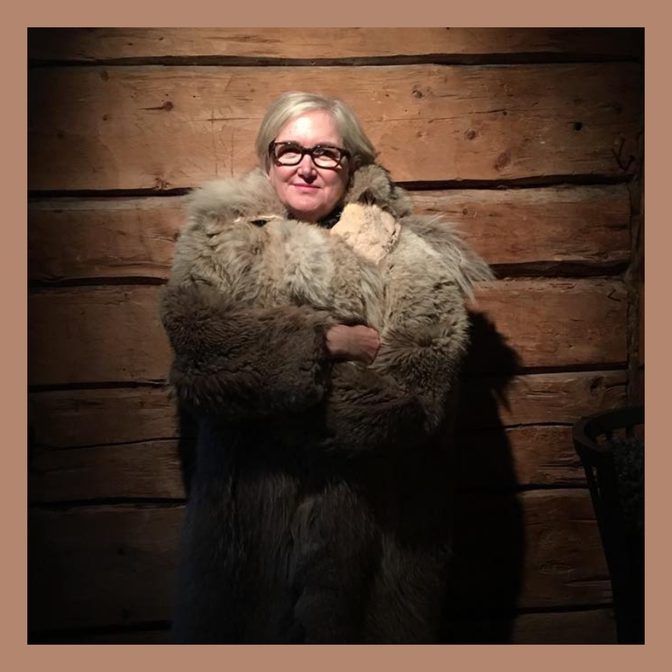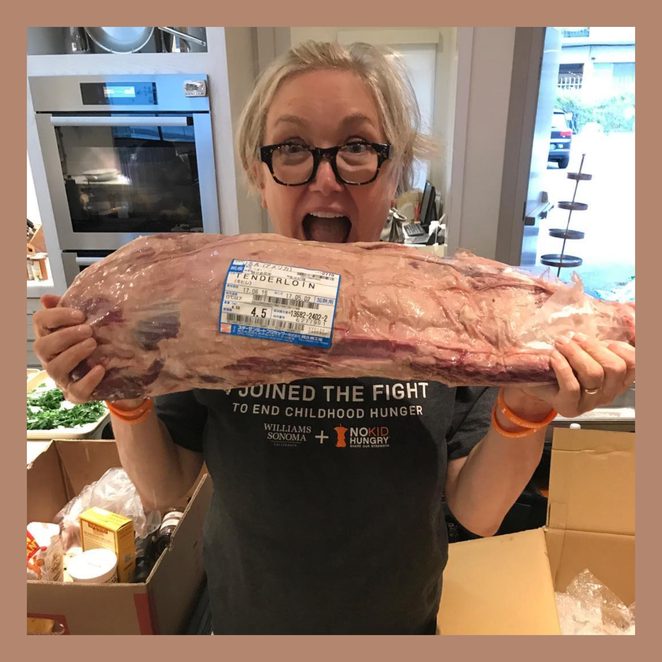March 2023: Issue 27
Rain, Rain Picking Finishes No Hunger Games Mom’s Lasagna
by Joey Wolosz | Published March 2, 2023
A Note from Joey Wolosz
Wow, California hasn’t seen this much rain and snow in March in a long time. Our reservoirs are full and overflowing, and the snowpack is high! March is definitely going out like a lion.
Jeff and I have been on a spree selecting floor and wall tiles, paint colors, hooks, handles, and delving into all trades, their gear, tackle, and trim for The Bungalow.
In the notes below I share a personal interview with a woman who has spent her career alongside some American culinary legends.
The first culinary legend that I learned from was my mother and I share her lasagna recipe. Trust me, it is worth making, it is the stuff of legend.
Save the date, October 7, 2023. It is the Yountville Days parade and Gentleman Farmer will be out in full force with the house band, Phat Ankle. Plan now to enjoy the afternoon as we take a day’s break from the upcoming harvest.
I’m in this to get as many people to the table and share interesting tastemakers, delicious food, worthy wine, and more. If you think of anyone who would like to join, please share Field Notes. I’m sure they’ll be happy you did.
Joey
Vintner, Cook, Collector of Dappled Things

I just read that over 78 trillion gallons of water have poured over California this winter, enough to fill the Rose Bowl in Pasadena 900,000 times and it is still raining! That’s a lot of agua. Our reservoirs are full as well as groundwater tables.
Some people ask about the effect of this weather on the vines. They are dormant in the winter and are fairly oblivious to the cats and dogs pouring down. Most of our vineyards are on well-draining soils with many feet of cobble under loam.
The valley vines are now wakening from their winter slumber with budbreak.

Jeff and I have been as active as dry yeast picking out all manner of finishes, furniture, and fixtures for our soon-to-be opened studio for your gustatory well-being. The Bungalow is well into its seventh month of construction and I’m pleased as punch with what’s coming together.
The space will have the Durham-Wołosz vibe and we look forward to hosting you very soon.

Among Food Giants
I had the pleasure of meeting Jean Armstrong in San Francisco at a Williams-Sonoma corporate holiday party. She is the Vice-President of Brand Marketing for the retailer and has been with them for over 37 years. I was taken by her stories of the American food legends that she knew and considered personal friends: Chuck Williams, Julia Child, and James Beard to name a few.
You can find her on Instagram @jeanarmstrongsf
This interview was recorded over Zoom, transcribed, and edited for clarity.

JW: We met last December at the Williams-Sonoma San Francisco corporate holiday party. I was fascinated by the brief information that you gave me about your history with the great trailblazers of the American food scene.
JA: They’re right in my office. There they are [pointing to photos]. Chuck Williams. Julia Child, and James Beard. I call them a terrific trio. You know, James Beard, Julia, and Chuck.
JW: Nice. Tell me about your work at Williams-Sonoma.
JA: I’m the VP of brand marketing for Williams-Sonoma. God, I touch a lot of different things. It started off that we just did things in the store, whether classes or events. I was fortunate enough that I’ve been in the field with Williams-Sonoma for 37 years. I’ve been a buyer with Williams-Sonoma. Chuck Williams mentored me, he became a very good friend of mine. I eventually moved into brand marketing. With all those experiences I try to keep that culture alive, of who we are as a brand, teaching people to cook, entertain, and having the answers for people.
Through Chuck, I met a lot of people, obviously. It’s kind of like seven degrees of separation. If you don’t know that person, then this other person can tell you who that person is. That’s how the culinary community operates. I think it’s like, oh, I know somebody who might know you who can make the introduction. That’s what we do. We’re connected all the time. It’s like the original LinkedIn, the community of the culinary. You go to a city and you may not know the restaurants there, but if you know a chef that’s been there… Supporting the culinary community has been always been really important to me. I think it’s an important part of who we are, what we are, and what we do every day. That’s a big part of my role.
Ideation is also a big part of what I do. What are the new ideas? What is happening, trying to understand where the next trends are. What are we doing? When I think about Julia Child, she never endorsed products, she would not, she was very close to track. but she never ended. She’s the one that taught Americans about how to make a souffle.
There are things I’m really proud of, we taught the stores to cook a lot. We were doing that a lot, I would say about 50 [per store, per year] 10 years ago, we were cooking like crazy. Then we went into the demonstration mode. It wasn’t as aggressive as it has been in the past, [it is now] more about selling, let’s be honest, when we are a retailer, but my job is to identify the trends, keep the partnerships and collaborations going, identify who or what’s the next new idea. I basically touch that. I’m involved with the merchants heavily. I’m involved with the creative and the content teams. I’ve traveled extensively as well. Because I’ve been a food buyer, I understand food quite well, and I read a lot. You cannot underestimate this, I don’t think we’re gonna be able to invent an AI that can read for us. Or maybe we are, but you know, who knows? I think there’s a responsibility in the community as well. One of the things I like about having all of those stores out there is that they’ve got their own communities.
We’ve built those communities. I think the other piece that I’m involved with heavily is No Kid Hungry. I was actually just talking to the gentleman who used to be the brand president for 30 years, Richard Harvey. We support St. Jude’s overall, as a brand WSI.
However, the individual brands have different organizations that they support. He said, “Go find me something.” Well, I grew up in the UK, and we grew up hungry, without food as a child. So we got involved with No Kid Hungry, and we’ve been doing that for about 12 years now and raise quite a lot of money for them. We’ve engaged the chef community and the celebrity community. We design spatulas that celebrities or chefs design. We sell them and raise money through our Point of Sale system. That’s a big part of what we do.
We support the Trevor Project, the NAACP, and of course, St. Jude’s. There are a lot of different things going on within the brand. I’ve got a really tiny team, we’ve got a couple of people working here and we’re just trying to keep it relevant all the time.
A big part of my world also has shifted, not just to the chef community, but to the vendor community as well, understanding what they’re going through, building those partnerships, making sure that we’re giving, basically acting as their agency almost with their product. We decide how we’re going to launch it, what we’re going to do with it.
I think the one thing that’s happened since COVID is my concern about the culinary community. When I look at San Francisco and the restaurant scene, I do not feel it is where it needs to be. It feels very lackluster. I think there’s a lot more going on in Oakland.
I think it has to do with economics as well. Let’s be honest, I mean, you’re paying your dishwasher $16 an hour and you have to pay the rent. We’re seeing restaurants open up and they’re doing just wine, sake, and beer.
In Oakland, I don’t if you’ve been there yet, but there are some really great, small restaurants. There is one where the chef gets the food from two farms. I think we’re going to see more of that happening. I actually hope it happens, because I think it’s a good way for us to go.
The thing about the chefs and the culinary community, people like yourself, is that they are givers, they are not takers. They are givers and they give and they give and they give and what I try to do is to support them. Let’s say Michael Voltaggio is doing something, I’ve known Michael and Bryan [Votaggio] for a long time, and they need 50 number-three ramekins on a Saturday. I’m the person that they go to. Those are the ways that I support them.
Also, I was getting recipes from chefs gratis. And I said we got to start paying these people. I said we’ve got to stop it. That’s one of the things I’m really proud of, that we’ve got them into a remuneration program.
We have a chef collective that we put together. The chef collective guys would choose a group of chefs to work with for about 18 months. They become part of the alumni. We are basically building that Chef community and giving voices to people who have not had a voice before, whether it’s women or underprivileged people of color.
One of the things I don’t think we’re talking about right now is Korean food. The kids are eating Korean food guys. It’s kind of like, yeah, they’ve moved on, this isn’t just about Chinese food or about Japanese food, it’s about a lot of other food cultures that are coming up and they’ll bring in just one Korean barbecue sauce to the store. But that’s not telling the true story of what it is. So that’s kind of what I do. Does that make sense?
JW: It does make sense. You have quite a history surrounding yourself with American food greats, Chuck Williams, Julia Child, MFK Fisher, James Beard, Richard Onley, Can you share how you connected with them and the stories behind these connections?
JA: A lot of it was connecting through book signings, like when Julia Child was doing them. Chuck was a personal friend of mine. James Beard did some book signings with us. That was a big part of it. I would say that Chuck is the one that I was the closest to.
Julia Child, I met her several times. She was not a person that was into the commercial part of it. She went on PBS and showed us all that it’s okay to drop the chicken on the floor. I think Chuck was the merchant and Julia taught us you could do this at home.
At that time, America had just gone through this massive shift. The 50s and the 60s was a time where everybody was interested in food that you could take out of the freezer. I mean, right after the Second World War, people were interested in what instant food looked like, that’s what happened.
They taught America how to cook, they taught that you can make this at home. They taught you know how roast great chickens. That’s what I think my connection is with them, keeping their books, stories, and recipes alive.
I make Yorkshire puddings. I cannot give you that Yorkshire pudding recipe, because I was taught by my grandmother how to make it. I just know that that’s the amount of flour. I have never measured the flour. I’ve never measured the amount of water or milk that I put in there. I know how many eggs to use. I think that they revolutionized the American kitchen for me.
JW: You mentioned it a little bit earlier. Tell me about your work on the Leadership Council with No Kid Hungry?
JA: The leadership council with No Kid Hungry is an incredible group of people who get together three times a year and talk about what’s going on with feeding our children and how we can impact it. No Kid Hungry is basically in Washington, DC, fighting for the SNAP (supplemental nutrition assistance payment) program, fighting for breakfast in our schools.
The way it used to work in this country is that kids would go to school, and there would be the kids that went to that side of the room that were getting the special breakfast and there were kids that didn’t have to worry about that. I think one of the things that No Kid Hungry has done is “breakfast for all.” They persuaded whole states to get behind this because the federal funding was there for it. The question is just, “how do you move that through?” That’s what the Leadership Council does. It raises funds and raises awareness levels. The thing about the breakfast is that they actually got schools to start the classroom at 8:15 in the morning, and for the first 15 minutes, they only had breakfast together. It doesn’t matter if you live in a trailer or whether you live in a mansion, everybody sits down and has breakfast together. It’s a great equalizer. It has improved math scores and reading skills because the kids are getting some food to start the day with.
Then there are the summer programs. Where do you get breakfast in the summer? Where do you get lunch? And one of the things that they did is they created hubs for people to be able to go pick up breakfast and lunch. People were picking up food for their families. When we started with No Kid Hungry, it was one in four children who were food insecure. That means they’re not getting enough food every day. Before the pandemic, we got to one in seven. So we made a major impact. It is now back down to one and four. I don’t know if you work with the food banks at all, but there are people turning up to food banks that never thought that would have to go to a food bank. There’s a lot of pressure. How do we keep investing? You’ve got to have people in Washington. The SNAP program is huge and they just rolled back the SNAP benefits for people. Those are the things that the leadership council gets involved in. Write a letter to Congress. I go to Washington, DC and I get inspired. I come back and I increase what am I going to raise this year. How do I tell a story? You’ve got to make the story, grow, keep on message and make sure that the story is compelling and the people understand what the need is. Does that help?
JW: Yes, very interesting. What are your creative outlets?
JA: Oh, boy. I would say, I love to entertain. I love to read. I already have a lot of creative work, because of what I get to do it. I get to sit in a room and ask, “what if?” What if we did this? I do that a lot. I’m pretty connected throughout the culinary community. I get to talk to people every week about what’s going on, what’s happening, what are the needs. I love to go out and eat. I like to go out and drink wine. You might know that. And travel. Travel is a big part of this. I have a home here and I also have a home in the UK. The UK is a great jumping-off spot for people anywhere in Europe.
JW: Friends and family excluded, who are two people you would like to share a long and lingering meal with, living or deceased, and what would you serve?
JA: There are two people really, and I think they get along really well. Anthony Bourdain and Chuck Williams. I think that would have that would be a very good table to sit at because I think that they represent different times. Anthony Bourdain was actually a very shy person. Chuck was much cleaner palette than Anthony actually. Tony would eat the eyeballs of sheep and everything, but I think that I would serve a really great Beef Wellington with duxelles and some good burgundy. I think that’d be great.
JW: Finally, what is your motto?
JA: My motto is to treat people the way that you want to be treated. You’ve got to keep it simple. I’m really aware of the words we use, when we say them, and how we say them. I think it’s really important. I try to keep that in mind.

Lasagna, my comfort food. Although mom was mostly Irish and dad was 100% Polish, my family made a mean lasagna. Jeff’s family is Italian, half from the north of Italy and half from Sicily. He will tell you rosemary is only for potatoes, basil is for Sunday sauce. However, even he is a convert to my mother’s liberal use of rosemary in her red sauce.
Enjoy with a glass or two of Gentleman Farmer Napa Valley Red Wine.
